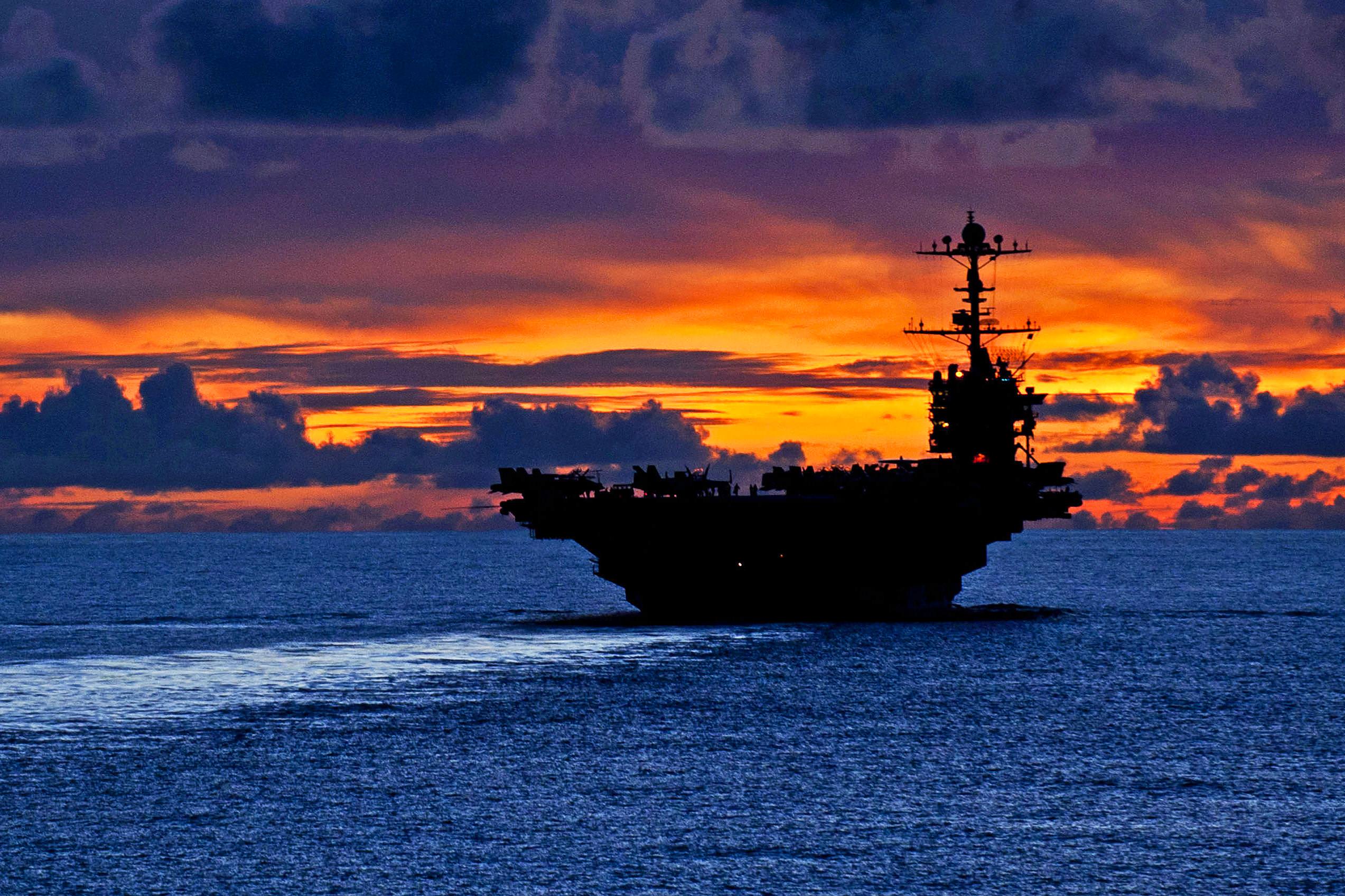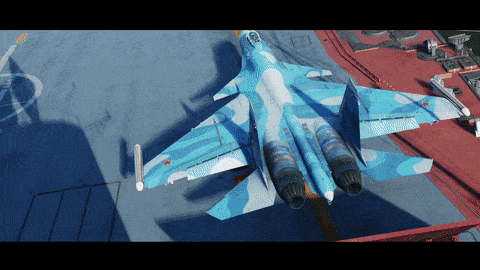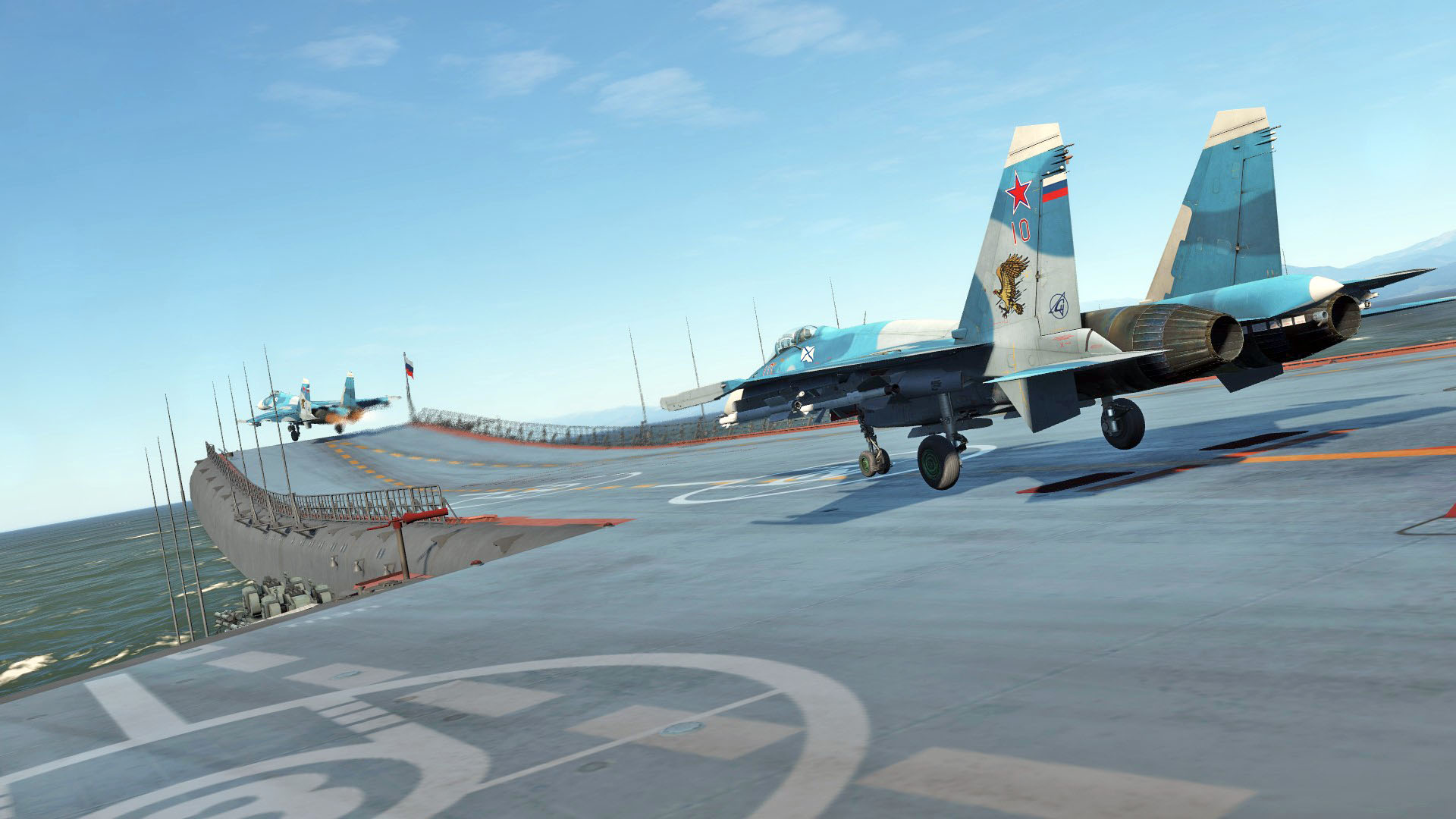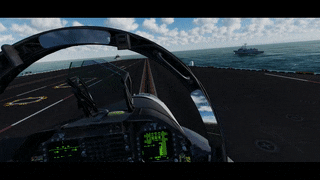Difference between revisions of "Carrier Air Operations"
(Carrier topology) |
|||
| Line 6: | Line 6: | ||
|height = 90px | |height = 90px | ||
}}</center> | }}</center> | ||
| + | |||
| + | [[File:AircraftCarrierNight.jpeg|350px|thumb|right|A home away from home for many naval aviators]] | ||
Carrier Air Operations are the various procedures and techniques that make up landing on a moving ship, usually several miles away from any solid ground on which you can land instead. Both fixed-wing and rotary wing aircraft can make use of aircraft carriers to land on, as well as STOL / STOVL aircraft such as the Harrier and the F-35B. Because of the relatively small size (compared to a fully fledged land-based airport) of the carrier, strict procedures and rules are employed to avoid accidents (such as airplanes crashing into one another). | Carrier Air Operations are the various procedures and techniques that make up landing on a moving ship, usually several miles away from any solid ground on which you can land instead. Both fixed-wing and rotary wing aircraft can make use of aircraft carriers to land on, as well as STOL / STOVL aircraft such as the Harrier and the F-35B. Because of the relatively small size (compared to a fully fledged land-based airport) of the carrier, strict procedures and rules are employed to avoid accidents (such as airplanes crashing into one another). | ||
| − | + | __TOC__ | |
== Carrier Basics == | == Carrier Basics == | ||
Revision as of 14:08, 13 October 2018
Carrier Air Operations are the various procedures and techniques that make up landing on a moving ship, usually several miles away from any solid ground on which you can land instead. Both fixed-wing and rotary wing aircraft can make use of aircraft carriers to land on, as well as STOL / STOVL aircraft such as the Harrier and the F-35B. Because of the relatively small size (compared to a fully fledged land-based airport) of the carrier, strict procedures and rules are employed to avoid accidents (such as airplanes crashing into one another).
Contents
Carrier Basics
Before we dive headfirst into the procedures and rules associated with carrier air operations, we will first go over the various basics that come into play when operating on a carrier. These include items such as how does a carrier work, what does a carrier look like, and what sort of key features should you pay attention to when you cannot make out left from right when operating on a busy carrier.
Carrier Features
Simply put an aircraft carrier is a floating airfield for naval aviators (pilots in the Navy and the Marine Corps) to take-off and land when doing their missions. Normally an airplane can use a fully sized runway for taking off or landing, with the size of these runways landing somewhere in the ballpark of 6000 - 12000 feet; such a size for a runway would produce an enormously long ship and would be unfeasible to have as a ship-based airfield as you would not be able to traverse rivers and canals with such a lengthy ship.
Rather than accommodate the ships length to allow for the lengthy take-off / landing area needed for conventional airplanes, all manner of studies and experiments have led to the design modification of the airplanes and the carriers instead to allow for landing and taking off from the carrier. This started all the way back to the early 1900's, though the carrier became a main staple just prior to / with the beginning of the Second World War.
Arresting gear
The fixed wing propeller planes in the Second World War had enough of a power-to-weight ratio to be able to safely take off from the carrier, but they could not slow down enough in time to safely land on the carrier. A rather simple but ingenious solution was devised: they would span a number of wires across the deck, and bolt a hook to the aircraft that could catch these wires. As soon as a landing aircraft trapped one of these arrestor wires it would slow down rapidly and be landed safely (although decelerated quite harshly). This system is still in use today (although severely upgraded) and is the method for safely putting fixed wing planes safely on the deck of the aircraft carrier (STOL/STOVL and helicopter aircraft obviously do not require the arresting wires, as they can land semi vertically on the carrier deck).
These arrestor wires are not fixed to the carrier itself (as that would put tremendous strain on the wires and the carrier), but are instead attached to a set of hydro-pneumatic systems that dispel the energy in a controlled fashion. Usually this is done by having a ram force a non-compressible fluid through a small diameter control valve, that only lets through so much fluid; this in turn slows the aircraft safely and relatively smoothly. In the early days a barrier (basically a large and strong net) was used as a backup for when an aircraft would fail to trap any wire; nowadays they are reserved for emergencies only. To faciliate the trapping of planes on carriers they have to be equipped with a hook to catch (or trap) one of the wires (typically up to 5 wires are used on carriers): because the landings are also tougher on the undercarriage of the airplanes, most naval based aircraft also have a much sturdier and bigger gear to be able to withstand the shock of landing on the carrier.
During the invention of the arrestor wires, the deck was typically rectangular in shape, meaning aircraft landing where in direct conflict with aircraft taking off (so it could not be done at the same time). It was not until the early 70's that they invented the angled landing deck, so that landing aircraft were offset by several degrees from the catapults and aircraft taking off; from then on both recoveries and takeoffs could be performed simultaneously.
Ski ramps (STOBAR)
In the early days of the carrier (World War 2) most carriers were ships over which a flat deck superstructure was built, to be used by the air carrier wing (planes). Although equipped with the previously mentioned arrestor gear and barrier, the take-off procedure was unceremoniously going to full power and simply leaping off the edge of the carrier going at full till. This was possible because of propeller planes having a high thrust-to-weight ratio: they put out a high amount of power whilst the total weight of the aircraft is relatively low.
Although the introduction of the jet engine into (naval) planes increased the produced overall power output, the addition of radar, targeting sensors and other electronics, as well as various types of air-to-air and air-to-ground weaponry meant a significant increase in overall weight. As over time the airplanes got heavier and heavier still, fixed wing aircraft lost their high thrust-to-weight ratio could not reliably take off under their own power any longer. The Russians / Soviet bloc adapted a stratagem of high thrust engines combined with weight restrictions and mandated lower overall weight of their aircraft; they also adopted the ski ramp on their carriers.
Visually and effectively similar to a ramp one might see at a ski resort, the planes line up on the designated positions on the carrier and removable chocks come up from inside the carrier deck to hold the aircraft in place. At the same time the JBD (Jet Blast Deflectors) are raised behind the aircraft: this allows the aircraft to spool up their jet engines to the maximum power setting, afterburning mode: some naval jet aircraft (particularly those of Russian variety) may have an additional engine power override mode reserved for use with carrier takeoffs. This does of course eat into the fuel reserves and also means the engine(s) require maintenance more often.
The ski ramp increases both the altitude (though marginally) and the Angle of Attack / attitude of the aircraft launched: the particular combination allows an aircraft with a high thrust-to-weight ratio to become airborne under its own power (there is no requirement on an external power source). The ramp itself also requires significantly less maintenance than the contemperary CATOBAR system used by most NATO countries and the US.
The largest drawback of the STOBAR ( Short Take-Off But Arrested Recovery ) ramp system overall is the reduced payload that an aircraft can bring with it, lest it gets too heavy to make the take off with the ski ramp system. It is a significant reduction in capability compared to the American catapult system, particularly in the amount of weaponry that can be brought. The fuel reduction is also a downside, but carrier planes typically refuel once airborne anyway to top off their tanks as they are rarely launched with full internal fuel: it does mean you stay on the tanker aircraft longer before you are completely refuelled.
Another drawback is the reduced size of the usable carrier deck, as you can not store aircraft on the ramp: CATOBAR aircraft carriers routinely block one or more of their catapults by parking aircraft on them, as they can still use the remaining catapults for launching aircraft.
Catapults (CATOBAR)
Rather than implement the CATOBAR ramp system, the United States (whom pioneered the system) and most NATO countries instead use the CATOBAR (Catapult Assisted Take-Off But Arrested Recovery system. This facilitated a larger redesign to the aircraft carrier, in which up to 4 catapults were placed to allow aircraft to be propelled forward using steam, or on newer aircraft carriers, using electromagnetic forces. The aircraft catapult is essentially a very large tube into which a shuttle is placed that can be moved freely: this shuttle is propelled forward using steam / electromagnetism and to this shuttle we attach the aircraft.
The aircraft can be attached with either a length of reinforced rope (called a bridle), which gets connected to a set of attachment points on the underbelly of the aircraft (and is released after launch), but in all aircraft after the Cold War the shuttle instead connects to the nosegear of the aircraft via the launch bar. This is a connecting bar that the pilot can lower via a switch in the cockpit, which then connects up to the shuttle to launch the entire aircraft; to allow the aircraft to run up its engines (either going full mil power or lighting the afterburners if the aircraft is carrying a particularly heavy load) something called a release bar. This bar allows the jets engines to come up to speed, as well as charging up the catapult with power: once the bar is released remotely by the shooter (the officer in charge of the catapult) the aircraft soars away off the end of the deck and hopefully into the sky.
Carrier Deck Layout
Carrier decks can be quite busy with both player and non-player controlled aircraft, so before we step on the busy boat, it imight be a good idea to familiarise ourselves with the overall carrier layout. Due to the small size and large amount of traffic it can often feel cramped on the boat, so knowing where you are going would be wise.
As you can see there a number of different locations that each have their own perhaps-not-so-flattering name within the naval vernacular (jargon). The figure shown here is a diagram of the USS Nimitz class carriers: although others carries vary slightly in size and form, the names for the locations can be generalized across all carriers (even non-NATO carriers such as the Admiral Kuznetsov).
The mission developer can choose to include a number of static objects (parked aircraft, munition carts) on the carrier deck as well: they will not be moving, but they are collideable should you run into them. Typically they will be put off to the side, but ensure that your catapult is not blocked prior to your take off attempt.
The most prevalent locations and features should be the catapults (numbered and marked in green) and the landing deck area (between the red stripes), which is where the arrestor wires are. In general it would be a good idea not to block these area (for any longer than absolutely necessary), lest you run into someone taking off or coming in for a landing. Typically you should have approximately 20 to 30 seconds interval between departures and landings, but try to stay alert and mindful of others. Lets break down the areas:
- 1. Landing Deck (between the red lines, with yellow centerline)
- This area is typically reserved for aircraft coming in to land, and if you thus need to cross it, ensure that there is no aircraft about to land. Cross quickly, and apologize to the poor sod who's landing you just interrupted. Note that the landing deck is offset (by approximately 9° from the carrier's course heading; the carrier heading itself is called the BRC (Base Recovery Course).
- 2. Catapults (in green)
- The catapults are used for taking off from the carrier (so try not to block them, either). Please note that catapult 1 and/or 2 may be regularly blocked by parked aircraft, as otherwise we can not all fit on the tiny carrier; catapult 3 & 4 meanwhile happily block the landing deck area when an aircraft is attached. Each catapult has its own JBD (Jet Blast Deflector), to avoid scorching other planes and/or blowing them overboard: they are raised automatically when you hook up to the catapult, but give them a second to extend fully before ramming that throttle forwards.
- 3. The Island (in purple)
- This is where all the important people sit, such as the air marshall / boss (in control of the air traffic), as well as the captain (who steers the boat).
- 4. Elevators (in blue)
- The elevators are used to ferry aircraft to above and below deck at the respective beginning and end of missions.
- 5. Crotch
- This area should not be used for parking either; typically on landing your velocity vector will point on this area (but do not land by pointing your velocity vector in this area, use the IFLOLS instead!).
- 6. Box
- The box houses the catapult officer (in charge of operating the catapults); there is a little cabin that raises out of the deck where the officer sits so he does not get wet (or get blasted by the aircraft).
- 7. Point
- The point is normally reserved for parking quick-reaction flights (such as CAP support), as this area gives the quickest and easiest (unhindered) access to catapults (1 & 2). Aircraft parked here may be hot-aligned to allow for quick response.
- 8. Corral
- It is a parking area between elevator 1 and 2, a nice calm place to survey the busy chaos that is the typical carrier deck.
- 9. Street
- This area is not meant for parking, but is instead a transit area serving the corral, elevator 1&2, as well as the sixpack. So try not to block it.
- 10. Sixpack
- Any landed aircraft will typically be directed to the sixpack for shutdown, or prior to taxiing to their final parking place. Threat it as a holding area of sorts: please note that if in the sixpack you can easily block the landing deck area, so take care to position yourself properly or you may find yourself missing your tail section / rudders / elevators.
- 11. Junkyard
- This is where they normally park the E-2 Hawkeye (AWACS) and C-2 Greyhound (cargo) aircraft, as well as the crane used for removing crashed aircraft and debris. Because these always looks like pieces of junk, this area is named the junkyard.
- 12. Patio
- A place that is far away from all the chaos on the carrier deck and gives you a nice view of aircraft trying to stick the landing on the landing deck area.
- 13. LSO
- This is where the guys sit that determine if you are within the Case 1/2/3 parameters and get to make it aboard, or if you have to wave off again and join the back of the line in the pattern before you get to try landing again.
- 14.Finger
- This parking area, aptly named for the gesture you may wish to make to their nearby LSO for waving you off again, requires you to taxi to the other end of the ship and inconvenience everyone on the way before you make it to where the catapults are.






